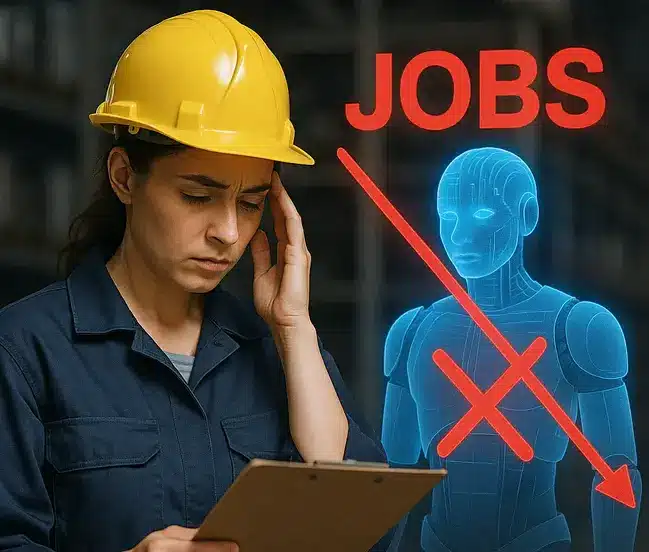We’re currently in the first third of the second stage of artificial intelligence development. Understanding these stages is critical for grasping what’s happening to employment worldwide. The first stage is ANI, or narrow artificial intelligence, which we’ve had for years. This includes Siri, face recognition software, photo editing tools, and language translation programs that have become commonplace.
The second stage, AGI or artificial general intelligence, began just a few years ago. The goal of AGI is to reach 100% capability where AI will know everything every human has ever known, becoming a PhD in every subject capable of responding with analysis within milliseconds. While this is already occurring at frightening speed, it’s not the scariest level.
The third and most concerning stage is ASI—artificial super intelligence. This represents AI systems that can rewrite their own code and evolve independently. What makes ASI particularly alarming is that AGI will actually help create ASI, meaning the process accelerates exponentially because general intelligence will contribute to building super intelligence.
We’re currently in early-middle AGI territory. Technologies like ChatGPT and more significantly Grok 4 demonstrate capabilities that Elon Musk himself has described as terrifying. The paradox is that Musk is funding technology he finds frightening, but as he and others explain, if they don’t develop it, someone else will. This creates an arms race where every major tech company must push forward or risk being left behind.
Using percentages to track AGI progress, the system used to operate at about 8% of full human capability. Right now Grok 4 sits at approximately 16% of 100. More concerning is that advancement isn’t linear—it’s accelerating exponentially. If it took one year to progress 8%, the next 8% might take only six months. This acceleration happens because AGI helps solve its own problems, creating faster and faster iteration cycles. Current projections suggest reaching 100% AGI within the next two years.
The 40 Jobs Disappearing in 2025
These projections are based on AGI reaching 30% capability by the end of this year. The list spans industries from technology to service work, and many positions will be almost entirely eliminated. Number one on the list is data entry clerks—typical office workers employed by medical billing companies, tax accountants, and countless other industries. Most of these jobs will vanish by year’s end as AI handles database population with perfect accuracy.
Telemarketers rank second, though this disproportionately impacts India rather than the United States. Most telemarketing occurs in India, creating cultural and linguistic barriers when calling Americans. AI eliminates these problems by speaking in perfect American accents or adapting to regional European dialects automatically. While Americans might celebrate fewer unwanted calls, this represents catastrophic unemployment for India—a nuclear power whose social stability matters globally.
Customer service representatives face near-total elimination. Whether handling technical support, returns, or product questions, these roles are being assumed by AI. Many workers in this industry have already lost their positions.
Software developers and engineers are being laid off by the dozens. Companies can now generate code using AGI, making many developer positions obsolete. Previously high-paying careers that once required specialized education now leave recent graduates desperate, with some considering fast food work.
Assembly line workers are increasingly replaced as AI controls robotic machinery that operates 24 hours without complaints or breaks. Retail cashiers are disappearing at stores like Walmart, though some resistance remains where customers value human interaction over speed. Bookkeepers, who handle payroll, taxes, and withholdings, are being replaced for accuracy reasons.
Receptionists managing phone calls and bookings are becoming obsolete. Payroll clerks processing employee payments no longer exist as AI handles bank coordination automatically. Inventory managers tracking warehouse stock face elimination. Travel agents once arranged complete trips, but AI now understands preferences, allergies, personalities, and plans nearly perfect customized vacations.
Proofreaders who verified AI-generated content quality are disappearing. Mail sorters in corporate mailrooms face replacement, though government positions may persist longer due to unions. Bank tellers represent a massive disruption as entire bank buildings close, moving to kiosks and advanced ATMs.
Automation Is Reshaping the Workforce
From proofreaders to bank tellers, automation is erasing roles once thought irreplaceable. AI verification, mail sorting, and in-person banking are all transitioning to digital systems and kiosks. The future belongs to professionals who evolve — adapting to data, automation, and human–machine collaboration.
Explore Automation & Workforce Transformation Roles →Junior Positions Hit First
The pattern emerging shows AI targets junior positions before senior roles. Data analysts are being replaced starting with entry-level workers before moving to senior positions. Financial analysts who studied Wall Street charts, graphs, and trends for investment decisions face complete automation. Project managers in middle management are disappearing as AI more efficiently implements executive vision.
Marketing assistants and coordinators are becoming extinct as AI generates marketing plans faster with better analytics. Social media managers maintaining corporate online presence face elimination. Graphics designers have been rendered nearly obsolete by AI’s ability to create realistic images and video quickly. Content monitors reviewing social media for offensive material are being automated.
Logistics coordinators at shipping companies like FedEx and UPS who plan deliveries and optimize routes face unemployment. Quality control inspectors watching assembly lines for defects are being replaced. Administrative assistants handling scheduling, document preparation, and executive support tasks are being eliminated.
Physical and Professional Roles
Web developers who created websites face near-total replacement as AI builds entire sites in seconds. Web developers may survive only by acting as intermediaries helping clients communicate with AI. Freelancers are already finding work disappearing.
Paralegals performing tedious legal work are being eliminated, and lawyers themselves may eventually be replaced as AI offers cheaper, potentially more effective representation. Loan officers at lower levels are disappearing as AI handles pre-screening. Event planners are being replaced because AI can customize events better and cheaper without imposing personal preferences.
Real estate agents face a third to half of positions disappearing as AI handles initial property matching. Copywriters are being automated. Warehouse workers at facilities like Amazon see robots replacing forklift operators and packers. Tax preparers including those at H&R Block face obsolescence as AI handles tax preparation more efficiently than traditional software.
Billing specialists sending invoices are being automated. Market research analysts are disappearing. Tutors and teachers face pressure as AI can provide one-on-one education for children who can’t get individual attention in crowded classrooms.
Geographic and Government Exceptions
Government jobs appear somewhat protected temporarily due to bureaucratic slowness and union resistance. However, companies with smaller budgets are already adopting AI solutions for courts and document organization. Government positions will ultimately face the same pressures as private sector roles.
The impact on India cannot be overstated. With millions employed in telemarketing and tech support, AI’s ability to handle these roles with perfect American accents represents potential social unrest in a nuclear power. The economic disruption will extend far beyond India to any country relying heavily on outsourcing.
As warehouse workers disappear from massive facilities that once employed thousands, some factories may run entirely with one or two human supervisors. The combination of physical automation and AI control means fewer jobs across multiple sectors simultaneously.
The Path Forward
The key to surviving this transformation appears to be shifting toward jobs that require distinctly human capabilities. Service industries like plumbing, electrical work, and hands-on trades may offer some protection. Human creativity, problem-solving, emotional intelligence, and physical manipulation skills represent areas where AI struggles.
However, the scope of disruption is unprecedented. What’s happening isn’t gradual change but rapid upheaval affecting millions globally. Those who adapt quickly, learn to work alongside AI rather than compete against it, and develop skills AI cannot replicate will fare best in the coming transformation.
Frequently Asked Questions
Q: How fast is AGI progressing?
A: Current estimates place AGI at about 16% of full capability, progressing from 8%. If it took one year to gain 8%, the next 8% takes six months—accelerating because AGI solves its own problems. Full AGI could arrive within two years.
Q: Which jobs are being hit first and hardest?
A: Junior positions across all fields face immediate elimination. Software developers, data analysts, customer service representatives, telemarketers, and data entry clerks are already being laid off in large numbers.
Q: Why is India being disproportionately impacted?
A: India’s economy relies heavily on outsourced telemarketing and tech support roles. AI can speak with perfect American accents, eliminating barriers that previously protected Indian workers while creating massive unemployment in a nuclear-armed nation.
Q: Are government jobs safer from AI replacement?
A: Temporarily yes, due to bureaucratic slowness and union resistance. However, smaller government operations are already adopting AI, and eventually all positions will face similar pressures as private sector roles.
Q: What types of jobs might be safest from AI?
A: Hands-on trades like plumbing, electrical work, and service jobs requiring physical presence, creativity, problem-solving, and emotional intelligence that AI cannot replicate may offer more protection.
Q: Is this happening right now in 2025?
A: Yes. Software developers are already being laid off by the dozens. Customer service jobs have already disappeared. Bank tellers are being terminated by the hundreds of thousands. This is not future speculation but current reality.




